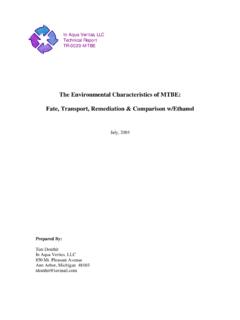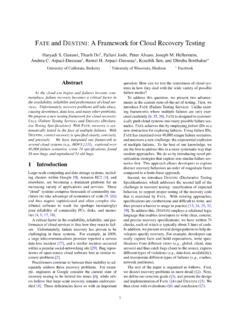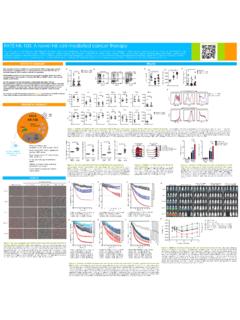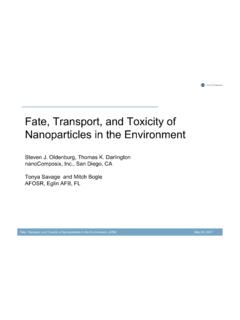Transcription of UNITED STATES ENVIRONMENTAL PROTECTION AGENCY
1 UNITED STATES ENVIRONMENTAL PROTECTION AGENCY WASHINGTON, D. C. 20460 OFFICE OF PREVENTION. PESTICIDES AND TOXIC SUBSTANCES Chemical: Imazapyr PC Code: 128821 DP Barcode: D275562 MEMORANDUM DATE: CHEMICALS: FROM: THRU: TO: 3 September 2003 Section 3 request for additional terrestrial uses and first time aquatic uses ofimazapyr (PC 128821, CAS Reg. No. 81334-34-1, AC 243997, CL 243997) and its isopropyl amine salt (PC 128829, CAS Reg. No. 81510-83-0, AC 252925, CL 252925) and sold as the herbicide product ARSENAL (EPA Reg. No. 241-346, BASF/American Cyanamid, Co. No. 000241) Stephen Carey, Biologist Alex Clem, ENVIRONMENTAL Scientist ENVIRONMENTAL Risk Branch III/EFED (7507C) Douglas Urban, Senior Scientist Stephanie Syslo, RAPL Ben Smith, Branch Chief Enviro11111ental Risk Branch IIIIEFED (7507C) Donald Stubbs, Branch Chief James Tompkins, Team Reviewer Herbicide BranchiRD (7505C) Attached please find the ENVIRONMENTAL Fate and Effects Division's (EFED) screening level ENVIRONMENTAL risk assessment for the proposed registration of new aquatic uses for the formulated product ARSENAL (EPA Reg.)
2 No. 241-346; active ingredient: imazapyr as isopropyl amine salt). In accordance with the agreement with Registration Division, the additional terrestrial uses requested by the registrant will not be considered at this time. Based on the proposed new product label, imazapyr is intended to control emerged and floating 1 vascular plants on non-crop bodies of freshwater that may be flowing, non-flowing, or transient. The non-crop freshwater aquatic sites encompass all manner of wetlands and transitional areas. The label lists "lakes, rivers, streams, ponds, seeps, drainage ditches, canals, reservoirs, swamps, bogs, marshes, transitional areas between terrestrial and aquatic sites, seasonal wet areas, and similar non-crop areas.
3 " The ARSENAL label specifies a maximum single application rate of 6 pints/acre of product, which is formulated as a concentrated solution of the isopropyl amine salt of the parent acid imazapyr. This application rate corresponds to lb/acre of acid equivalents ( ) ofimazapyr. However, the label does not explicitly specify a maximum number of applications per season/year or a maximum seasonal rate for these proposed uses. In lieu of these maximums, EFED chose to use the maximum single application rate of lb of imazapyr as the annual maximum input for use in model estimates of potential exposure. This adds uncertainty to the results and conclusions of this assessment. In addition, because of imazapyr' s persistence, splitting applications while maintaining a total of lb annually would not result in meaningful alteration of exposure concentrations or risk conclusions.
4 Potential risks to aquatic organisms (fish, invertebrates, and plants) and terrestrial organisms (birds, mammals, and plants) are assessed based on modeled Expected ENVIRONMENTAL Concentrations (EECs). This document also includes an assessment of potential imazapyr residues in drinking water. Key findings of this risk assessment are as follows: Levels of Concern (LOCs) are exceeded for non-target endangered and non-endangered vascular aquatic plants. Thus, the proposed aquatic uses of imazapyr present a potential risk to endangered and non-endangered aquatic vascular plants. Since imazapyr is persistent in water and soil, the potential risk to these vascular plants could last for a relatively long time, perhaps as long as several years.
5 Levels of Concern (LOCs) are exceeded for non-target endangered and non-endangered terrestrial plants. Thus, the proposed aquatic uses of imazapyr on use sites described as "transitional areas between terrestrial and aquatic sites" pose potential risks to non-target endangered and non-endangered terrestrial plants. EFED considers applications to these sites equivalent to applications to terrestrial non-crop sites. In addition, drift from ground and aerial applications to the proposed aquatic sites also poses potential risks to non-target endangered and non-endangered terrestrial plants. Levels of Concern (LOCs) are not exceeded for aquatic and terrestrial animals and aquatic non-vascular plants ( , algae). Available studies suggest that the proposed aquatic uses of imazapyr are not likely to pose risks to these non-target organisms; however, additional information is needed to conclusively rule out chronic risks to birds.
6 Risks to honey bees from technical imazapyr are not expected and precautionary labeling is not required. 2 Estimated concentrations in drinking water are based on direct application of imazapyr at the maximum single aerial application rate of lb to the entire surface of the Index Reservoir. This yields an annual estimated peak concentration (acute) of 61 ,..,g/L (part per billion, or ppb). Applying this result to the FIRST model, which for this case considers only aquatic degradation and outflow dilution, the model yields an annual mean concentration (chronic) of36 ,..,g/L. EFED also recommends a number of changes to the proposed label to reduce the potential risk to non-target plants. Data Requirements Ecological Effects Avian Reproduction: EFED recommends that the avian reproduction toxicity test using the mallard duck (71-4b) as the test species be repeated.
7 The current mallard reproduction study is scientifically invalid due to bacterial contamination and high embryonic mortality in the control group. Typically, testing using two avian species (bobwhite quail and mallard duck) are required to fulfill Subdivision E Guideline 71-4, and to complete a characterization ofthe chronic risk ofimazapyr to birds. Because the proposed use is for aquatic sites, toxicity testing with an aquatic bird is especially needed. In addition, the invalid study submitted for mallard ducks indicated there might be reproductive effects. Nevertheless, given that imazapyr was practically nontoxic to the bobwhite quail, the value added of repeating this study is medium. Terrestrial plant: EFED recommends that the Tier II Seedling Emergence (123-1a) be repeated.
8 After reevaluation with the use of a newer model for a dose-response regression analysis, it was determined that the data in the current vegetative vigor study (MRID 40811801)) were inadequate for determining the EC25 and NOAEC values. In addition, there were numerous guideline deviations according to today's standard protocols. The study does not fulfill the guideline requirements because each species was subjected to overcrowding and excessive competition, especially larger seedlings, wherein ten seeds of each species were planted in a 4-in diameter dixie cup and grown (tested) to 28 days. The area of the pot container may have restricted seedling growth and thereby overestimated EC25 and NOAEC. The study is classified as supplemental for this use.
9 This study should be repeated with a full set of 10 species with appropriate area of the pot container to allow unrestricted growth and reduce competition of the plants. The use ofTEP (typical end-use product) instead of technical grade active ingredient is required for all terrestrial nontarget plant tests with the highest percent active ingredient used. 3 Because of the potential for runoffto adjacent areas from application sites to cause adverse effects on nontarget plants, the value added by repeating this study is high. EFED also recommends that the Tier II vegetative vigor test (123-1 b) be repeated. After reevaluation with the use of a newer model for a dose-response regression analysis, it was determined that the data in the current vegetative vigor study (MRID 40811801) were inadequate for determining the EC25 and NOAEC values.
10 In addition there were numerous guideline deviations according to today's standard protocols. The study is scientifically sound in that it establishes that imazapyr is highly toxic to terrestrial plants, but it does not fulfill the guideline requirements because insufficient dose levels were used in the portion ofthe 14-day study using young plants to EC25 and NOAEC levels. In addition, the toxicity values generated from the portion of the 28-day study using older plants could be underestimated since the plants were tested at a less sensitive stage of growth. This study is required to be repeated with a full set of 10 species with appropriate concentration levels for reliable EC25 values with plants applied at the second or third true leaf stage.



















